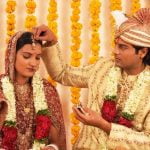Are you wondering how to address wedding invitations for your big day? Properly addressing wedding invitations is an essential part of wedding planning that sets the tone for your special event.
It’s not just about getting the names and addresses right, but also about showing respect to your guests and making them feel special. In this article, we will cover traditional and modern etiquette for addressing wedding invitations, as well as provide a step-by-step guide and creative ideas to help you address your invitations with style and grace.
Addressing wedding invitations may seem like a minor detail in comparison to choosing the perfect dress or venue, but it plays a significant role in the overall experience for both you as the host and your guests. The way you address an invitation can convey formality, intimacy, or even fun, depending on the style of your event.
Whether you’re following traditional etiquette or breaking new ground with modern trends, how you address your wedding invitations is an important aspect of setting the stage for your celebration.
In the following sections, we will delve into traditional and modern etiquette for addressing wedding invitations to guide you through this process. We’ll also provide a step-by-step guide on how to properly address wedding invitations with specific examples for different scenarios such as divorced parents or same-sex couples. Additionally, we will discuss common mistakes to avoid when addressing wedding invitations and present creative ideas to make your invites unique.
And finally, we’ll point out resources where you can find beautiful calligraphy or addressing services for your wedding invitations. So let’s get started on making sure every detail of your special day is just right.
Traditional Etiquette for Addressing Wedding Invitations
Addressing wedding invitations is an important step in the wedding planning process. It sets the tone for the event and shows respect to your guests. Here are some traditional etiquette guidelines to follow when addressing wedding invitations:
- Use proper titles: When addressing married couples, use “Mr. and Mrs. John Smith.” For unmarried couples living together, write each name on a separate line. For same-sex couples, list their names in alphabetical order.
- Include middle names: It is customary to include the middle names of the recipients, especially if they are close relatives or friends.
- Spell out all words: Avoid using abbreviations when writing out street addresses, states, and titles (such as Doctor or Street).
When it comes to addressing envelopes for your wedding invitations, there are several traditional rules that you may want to follow. These rules not only show respect for your guests but also add an elegant touch to your invitation suite.
- Avoid using nicknames or informal titles
- Use appropriate suffixes such as Jr. Sr. or III if applicable
- When inviting families with children, list the parents’ names on the first line followed by “and family” or specifically name the children if that is preferred
By following these traditional guidelines for addressing wedding invitations, you can ensure that your invitations are well-received and set the tone for a beautiful and elegant wedding celebration.
Modern Etiquette for Addressing Wedding Invitations
Addressing wedding invitations is an essential part of the wedding planning process. It sets the tone for the event and shows respect to the guests who will be attending. While traditional etiquette for addressing wedding invitations still holds value, modern times call for more flexibility and inclusivity. Here are some modern etiquette guidelines on how to address wedding invitations to ensure that you are respectful and considerate of all your guests.
When it comes to addressing wedding invitations in the modern age, it’s important to be mindful of diversity and inclusivity. For couples with same-sex partners, it’s appropriate to list both individuals’ names on the invitation, using their full names or titles as they prefer. Similarly, for couples with different last names or unmarried partners, you can address the invitation using “Ms.” or “Mr.” followed by their individual names.
Another aspect of modern etiquette when addressing wedding invitations is taking into account various familial situations. In cases where parents are divorced and each have different partners, it is respectful to address each individual separately on the invitation. This shows consideration for everyone involved and avoids any potential discomfort for guests.
In today’s digital age, many couples opt to use online platforms for RSVPs and communication regarding their wedding. When following this route, it’s still crucial to address physical invitations with proper care and respect. Despite the evolving times, sending out physical wedding invitations continues to be a cherished tradition that deserves attention and thoughtfulness.
Step-by-Step Guide on How to Address Wedding Invitations
When it comes to addressing wedding invitations, it’s important to follow proper etiquette and ensure that every guest feels valued and respected. Whether you’re sending out traditional paper invitations or digital ones, the way you address them sets the tone for your big day and shows your guests that you’ve put thought into their presence at your wedding.
First and foremost, it’s crucial to gather all of the necessary information for your guest list. This includes full names, titles (such as Dr. or military titles), and addresses. Once you have this information, you can begin the process of addressing your invitations.
Here is a step-by-step guide on how to address wedding invitations:
1. Outer Envelope: The outer envelope should include titles and last names only (e.g. Mr. and Mrs. Smith). It’s important not to include first names or nicknames on the outer envelope.
2. Inner Envelope: The inner envelope is where you include the first names of each invited guest along with their last name (e.g. John and Jane Smith).
3. Response Card: Make sure to include a pre-addressed and stamped response card with each invitation so that guests can easily RSVP.
By following these steps, you will ensure that your wedding invitations are properly addressed and reflect the respect and gratitude you have for your guests’ attendance on your special day.
| Step | Description |
|---|---|
| 1 | Outer Envelope should include titles and last names only |
| 2 | Inner Envelope includes first names of invited guests along with their last name. |
| 3 | A pre-addressed and stamped response card should be included with each invitation. |
Addressing Wedding Invitations for Different Scenarios (Eg Divorced Parents, Same-Sex Couples, Etc)
When it comes to addressing wedding invitations for different scenarios, it’s important to be sensitive and considerate of each individual or couple’s situation. One common scenario that couples may face when addressing wedding invitations is dealing with divorced parents.
In this case, both parents should be addressed separately, listing their names on separate lines without the use of “and” or “together with.” For example, the invitation may read “Ms. Jane Smith” on one line and “Mr. John Johnson” on the next line.
Another scenario that may arise is when addressing invitations to same-sex couples. The proper etiquette for addressing invitations to same-sex couples follows the same guidelines as any other couple. Both individuals’ names should be listed on separate lines without the use of gender-specific titles like “Mr.” or “Mrs.” For example, it could read “Ms. Alex Johnson” and “Ms. Taylor Smith”.
It’s important to recognize that every family dynamic is unique, and there may be other scenarios that require special consideration when addressing wedding invitations. Whether it’s blended families, unmarried couples living together, or other non-traditional situations, being respectful and honoring each individual’s identity and relationships is key. Taking the time to address wedding invitations in a thoughtful manner can help ensure that all guests feel valued and included in the celebration of love and commitment.
Common Mistakes to Avoid When Addressing Wedding Invitations
When addressing wedding invitations, it’s important to be mindful of potential mistakes that can easily be made. These mistakes can range from simple etiquette errors to more substantial issues that could cause offense to your guests. By being aware of these common mistakes, you can ensure that your wedding invitations are sent out with the utmost care and consideration.
Misspelling Names
One of the most common mistakes when addressing wedding invitations is misspelling the names of your guests. Whether it’s a simple typo or a misunderstanding of the correct spelling, this error can easily be avoided by double-checking the spelling of each guest’s name before addressing the invitation. It’s also a good idea to ask for input from family members or friends if you’re unsure about the spelling of certain names.
Incorrect Titles and Prefixes
Another common mistake is using incorrect titles or prefixes when addressing wedding invitations. It’s important to use proper titles such as “Mr.” and “Mrs.” for married couples, “Ms.” for single women, and “Miss” for young girls. Additionally, it’s crucial to use the appropriate prefixes for individuals with professional or military titles, such as “Doctor,” “Judge,” or “Captain.” When in doubt, do some research or consult with someone who is knowledgeable about traditional etiquette.
Omitting Important Guests
It’s essential to ensure that all important guests are included on the wedding invitation. This includes not only immediate family members and close friends but also anyone else who should rightfully receive an invitation, such as significant others or long-time partners of invited guests. By carefully considering your guest list and making sure no one is unintentionally left out, you can avoid awkward situations and hurt feelings.
By being mindful of these common mistakes when addressing wedding invitations, you can ensure that your invitations are sent out with care and respect for your guests. Addressing wedding invitations is an important aspect of the overall wedding planning process, so taking the time to avoid these mistakes will help set a positive tone for your special day.
Creative and Unique Ideas for Addressing Wedding Invitations
When it comes to addressing wedding invitations, there are endless creative and unique ideas that can add a personal touch to your special day. From incorporating elements of your love story to choosing unconventional materials, there are plenty of ways to make your wedding invitations stand out. Here are a few ideas to consider when addressing your wedding invitations:
Incorporate Your Love Story
One creative idea for addressing wedding invitations is to incorporate elements of your love story into the design. For example, you could use a map of the city where you first met or got engaged as the envelope liner. You could also include a timeline of significant events in your relationship as part of the invitation suite. These personalized touches will not only make your invitations unique but also allow guests to share in your love story.
Use Unconventional Materials
Another creative idea for addressing wedding invitations is to use unconventional materials. Instead of traditional paper envelopes, consider using wooden or acrylic boxes with the addresses engraved or printed on the surface. You could also use fabric envelopes or even etch the addresses onto glass bottles for a truly unique presentation. Play around with different textures and materials to create an invitation that reflects your personalities and sets the tone for your big day.
Incorporate Hand-Drawn Elements
If you’re looking for a more artistic and one-of-a-kind approach, consider incorporating hand-drawn elements into your wedding invitations. Whether it’s custom illustrations, calligraphy, or watercolor designs, these hand-crafted details can add a whimsical and personal touch to your invites. This not only adds a unique flair to each invitation but also shows the amount of care and thought put into each one.
These creative and unique ideas for addressing wedding invitations are just some examples of how you can make this aspect of wedding planning truly special and memorable.
Incorporating elements from important moments in your relationship, using unconventional materials, or adding hand-drawn elements can elevate the beauty and significance of your wedding invitation process while allowing you an opportunity for impactful personal expression. No matter what route you choose, remember that it’s all about sharing who you are as a couple while inviting loved ones to be part of this joyous celebration.
Resources for Finding Beautiful Calligraphy or Addressing Services for Wedding Invitations
In conclusion, addressing wedding invitations is a crucial part of the wedding planning process and sets the stage for the event itself. It is essential to understand both traditional and modern etiquette when it comes to addressing invitations, as well as how to navigate different scenarios such as divorced parents or same-sex couples. By following a step-by-step guide, couples can ensure that their invitations are addressed properly and reflect their unique circumstances.
For those who want to go the extra mile, there are resources available for finding beautiful calligraphy or addressing services for wedding invitations. These services can add a touch of elegance and personalization to the wedding invitation process, creating a lasting impression on guests.
It’s important to remember that while traditional etiquette provides a solid foundation, there is also room for creativity and uniqueness when it comes to addressing wedding invitations. Couples should not be afraid to think outside the box and explore new ideas that truly reflect their personality and style.
Ultimately, properly addressing wedding invitations sets the tone for the special day and shows guests that their presence is valued. With these resources and guidelines in mind, couples can confidently address their wedding invitations with grace and style.
Frequently Asked Questions
What Is the Proper Way to Address a Wedding Invitation?
The proper way to address a wedding invitation is to use formal titles and full names. This means using “Mr.” for adult men, “Mrs.” for married women, and “Ms.” for unmarried or feminist women.
Should You Use Mr and Mrs on Wedding Invitations?
It is traditional to use “Mr. and Mrs.” on wedding invitations when addressing a married couple, with the husband’s first and last name included. However, it is also appropriate to use separate titles and full names for each individual.
What Name Do You Put on Wedding Invitations?
When it comes to the names on wedding invitations, it’s important to include the full names of both the bride and groom. This means using their first and last names without any nicknames or abbreviations to ensure formality and inclusivity of all guests involved in the event.

Welcome to my blog about home and family. This blog is a place where I will share my thoughts, ideas, and experiences related to these important topics. I am a stay-at-home mom with two young children. I hope you enjoy reading it! and may find some helpful tips and ideas that will make your home and family life even better!





